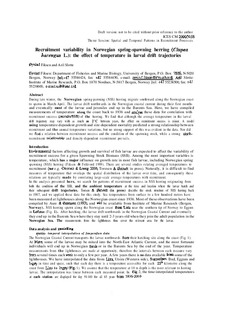| dc.contributor.author | Fiksen, Øyvind | |
| dc.contributor.author | Slotte, Aril | |
| dc.date.accessioned | 2007-07-17T09:50:09Z | |
| dc.date.issued | 2000 | |
| dc.identifier.uri | http://hdl.handle.net/11250/100445 | |
| dc.description.abstract | During late winter, the Norwegian spring-pawning (NSS) herring migrate southward along the Norwegian coast
to spawn in March-April. The larvae drift northwards in the Norwegian coastal current during their first months
and eventually most of the larvae and juveniles end up in the Barents Sea. Here, we have compiled
measurements of temperature alon, 0 the coast back to 1936 and analyse these data for correlation with
recruitment success (recruits/SSB) of the herring. We find that although the average temperature in the larval
drift trajectory may vary with as much as 2°C between years, the effect on recruitment success is minor. A model
using temperature-dependent growth and size-dependent mortality predicted a strong relationship between
recruitment and the annual temperature variations, but no strong support of this was evident in the data. Nor did
we fmd a relation between recruitment success and the condition of the spawning stock, while a strong stockrecruitment
rdationship and density-dependent recruitment prevails. | en |
| dc.format.extent | 976327 bytes | |
| dc.format.mimetype | application/pdf | |
| dc.language.iso | eng | en |
| dc.publisher | ICES | en |
| dc.relation.ispartofseries | ICES CM documents | en |
| dc.relation.ispartofseries | 2000/N:08 | en |
| dc.subject | herring | en |
| dc.subject | sild | en |
| dc.subject | recruitment | en |
| dc.subject | rekruttering | |
| dc.title | Recruitment variability in Norwegian spring-spawning herring (Clupea harengus L.): the effect of temperature in larval drift trajectories | en |
| dc.type | Working paper | en |
| dc.subject.nsi | VDP::Mathematics and natural science: 400::Geosciences: 450::Oceanography: 452 | |
| dc.subject.nsi | VDP::Agriculture and fishery disciplines: 900::Fisheries science: 920 | |
| dc.source.pagenumber | 6 s. | en |
